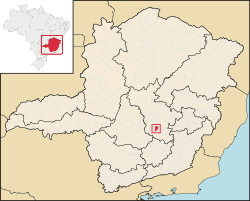
Back Belo Horizonte Afrikaans በሎሪዞንቺ Amharic Belo Horizonte AN بيلو هوريزونتي Arabic بيلو هوريزونتى ARZ Belo Horizonte AST Belu-Orizonti Azerbaijani Bélo Horizonté BAN Белу-Арызонты Byelorussian Бэлу-Арызонці BE-X-OLD
Belo Horizonte | |
|---|---|
| Municipality of Belo Horizonte | |
Panorama of Belo Horizonte, with Belvedere neighborhood in the foreground Aerial view of Praça da Liberdade Municipal Park Monument to Civilization in Minas, at Rui Barbosa Square Afonso Pena Avenue | |
Nicknames:
| |
 Location in Minas Gerais | |
| Coordinates: 19°55′S 43°56′W / 19.917°S 43.933°W | |
| Country | |
| State | Minas Gerais |
| Region | Southeast |
| Intermediate Region | Belo Horizonte |
| Immediate Region | Belo Horizonte |
| Founded | December 12, 1897 |
| Government | |
| • Body | Municipal Chamber |
| • Mayor | Fuad Noman (PSD) |
| Area | |
| 331.354 km2 (127.936 sq mi) | |
| • Urban | 282.3 km2 (109.0 sq mi) |
| • Metro | 9,459.1 km2 (3,652.2 sq mi) |
| Elevation | 852 m (2,795 ft) |
| Population | |
| 2,315,560 | |
| • Rank | 6th |
| • Density | 7,000/km2 (18,000/sq mi) |
| • Metro | 6,006,887 (3rd) |
| • Metro density | 635/km2 (1,640/sq mi) |
| Demonym | belo-horizontino(a) |
| GDP (PPP, constant 2015 values) | |
| • Year | 2023 |
| • Total (Metro) | $84.8 billion[3] |
| • Per capita | $15,900 |
| Time zone | UTC−3 (BRT) |
| Postal code | 30000-001 to 31999-999 |
| Area code | +55 31 |
| HDI (2010) | 0.810 very high[4] |
| Major airport | Belo Horizonte International Airport |
| Federal Highways | |
| State highways | |
| Passenger rail | Vitória-Minas Railway |
| Commuter rail | |
| Website | www |
Belo Horizonte[5] is the sixth-largest city in Brazil, with a population of around 2.3 million, and the third largest metropolitan area, containing a population of 6 million.[6] It is the 13th-largest city in South America and the 18th-largest in the Americas. The metropolis is anchor to the Belo Horizonte metropolitan area, ranked as the third most populous metropolitan area in Brazil and the 17th most populous in the Americas. Belo Horizonte is the capital of the state of Minas Gerais, Brazil's second-most populous state. It is the first planned modern city in Brazil.
The region was first settled in the early 18th century, but the city as it is known today was planned and constructed in the 1890s to replace Ouro Preto as the capital of Minas Gerais. The city features a mixture of contemporary and classical buildings and is home to several modern Brazilian architectural icons, most notably the Pampulha Complex. In planning the city, Aarão Reis and Francisco Bicalho sought inspiration in the urban planning of Washington, D.C.[7] The city has employed notable programs in urban revitalization and food security, for which it has been awarded international accolades.
The city is built on several hills, and is completely surrounded by mountains.[8] There are several large parks in the surroundings of Belo Horizonte. The Mangabeiras Park (Parque das Mangabeiras), 6 km (4 mi) southeast of the city centre in the hills of Curral Ridge (Serra do Curral), has a broad view of the city. It has an area of 2.35 km2 (580 acres), of which 0.9 km2 (220 acres) is covered by the native forest. The Jambreiro Woods (Mata do Jambreiro) nature reserve extends over 912 hectares (2,250 acres), with vegetation typical of the Atlantic Forest. More than 100 species of birds inhabit the reserve, as well as 10 species of mammals.
Belo Horizonte was one of the host cities of the 1950 and the 2014 FIFA World Cup. Additionally, the city shared as host of the 2013 FIFA Confederations Cup and the football tournament during the 2016 Summer Olympics.
- ^ a b "Belo Horizonte". Cidades IBGE. Retrieved September 20, 2022.
- ^ "Estudo realiza medição de altitudes em Belo Horizonte". Prefeitura Belo Horizonte. November 20, 2017. Retrieved November 15, 2021.
- ^ "TelluBase—Brazil Fact Sheet (Tellusant Public Service Series)" (PDF). Tellusant. Retrieved January 11, 2024.
- ^ "Archived copy" (PDF). United Nations Development Programme (UNDP). Archived from the original (PDF) on July 8, 2014. Retrieved November 15, 2021.
{{cite web}}: CS1 maint: archived copy as title (link) - ^ (UK: /ˈbɛloʊ ˌɒrɪˈzɒnti/ BEL-oh ORR-iz-ON-tee, US: /ˈbeɪloʊ ˌhɒr-/ BAY-loh HORR-, Portuguese: [ˈbɛl(w) oɾiˈzõtʃi] ⓘ; lit. 'Beautiful Horizon')
- ^ "DISTRIBUIÇÃO DA POPULAÇÃO BRASILEIRA E DOS MUNICÍPIOS, SEGUNDO GRUPOS DE TAMANHO DE MUNICÍPIOS" (XLSX). Agenciadenoticias.ibge.gov.br. Retrieved March 9, 2022.
- ^ "Belo Horizonte in Brazil Travel". V-brazil.com. Archived from the original on July 12, 2008. Retrieved April 17, 2011.
- ^ "About Belo Horizonte". World66.com. Archived from the original on May 14, 2011. Retrieved April 17, 2011.











